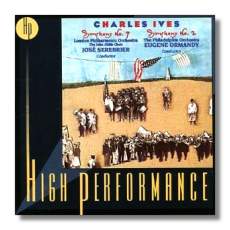
The Internet's Premier Classical Music Source
Related Links
- Ives Reviews
- Latest Reviews
- More Reviews
-
By Composer
-
Collections
DVD & Blu-ray
Books
Concert Reviews
Articles/Interviews
Software
Audio
Search Amazon
Recommended Links
Site News
 CD Review
CD Review
Charles Ives

Symphonies #2 & 4
- Symphony #2 (1902)
- Symphony #4 (1916)
Philadelphia Orchestra/Eugene Ormandy
London Philharmonic Orchestra & John Alldis Choir/José Serebrier
RCA High Performance 09026-63316-2 ADD 74:16
While Eugene Ormandy's fame derived largely from his recordings of short, popular pieces, I feel that his strengths lay somewhere else. Case in point: this recording of Ives' Second Symphony, which Ormandy recorded in 1973, strikes me as the work's finest hour on disc, even better than either of the much acclaimed Bernstein versions. Ormandy is totally self-effacing in this score, unlike Bernstein who never lets you forget his (admittedly significant) showmanship. Oddly enough, the Hungarian-born conductor makes Ives' Second sound more American than Bernstein, the quintessential New Yorker, does. Ormandy invests the quotations and near-quotations with an easy grace and a natural flow. Bernstein's emphatic "selling" of the score is absent here. Would Ives have liked it? The story goes that he found Bernstein's performances from the 1950s "too slow." In the second and fifth movements, Ormandy is even slower, although he is somewhat faster in the third movement. What matters is that all of his tempo decisions work, thanks to the affectionate playing of the Philadelphians. I was not prepared to like this recording as much as I now do. Anyone who finds Ives merely noisy will reconsider after hearing Ormandy, who seems to have a genial smile on his face from the first note to the last.
In the 1960s, José Serebrier assisted Leopold Stokowski in making the landmark Columbia recording of Ives' Fourth Symphony. Although Stokowski's recording is a classic, Serebrier's own recording of the Fourth is fully competitive, and in some ways even preferable. Serebrier took infinite pains to prepare the London Philharmonic for the sessions, which were made under trying conditions. He also painstakingly corrected errors and "improvements" that had crept into the orchestral parts over the years. As it is, in a score as complex as this one, any two performances or recordings are bound to be wildly dissimilar. At times, Serebrier's recording will convince you that you are listening to a completely different symphony than the one that Stokowski recorded! The old maestro's version is full of approximations; Serebrier's has the benefit of dozens of hours of rehearsal and recording time. Serebrier also makes more of Ives' dynamic indications and polyrhythmic flights of fancy. Nevertheless, the symphony sounds spontaneous – quite an achievement. The musicians don't always play "nice," particularly in the second movement, and this also is an improvement over Stokowski's version, where his orchestra must be happy just to play the right notes at about the right time! (Interpretation be damned!)
As with earlier High Performance issues, the quality of the recording is revelatory. The dynamic range is wide, and the instruments sound warm and detailed. The only minor disappointment is a hint of distortion in the choral passages in the Fourth's first movement. This problem soon disappears, and nothing else interferes with enjoying these extremely fine versions of Ives' idiosyncratic symphonic masterpieces.
Copyright © 1999, Raymond Tuttle




















